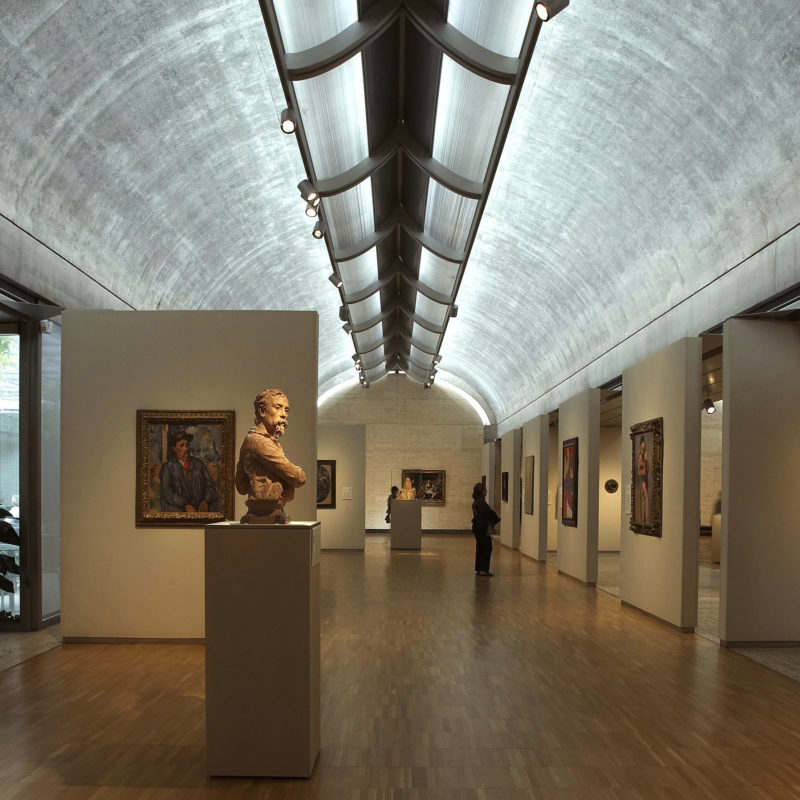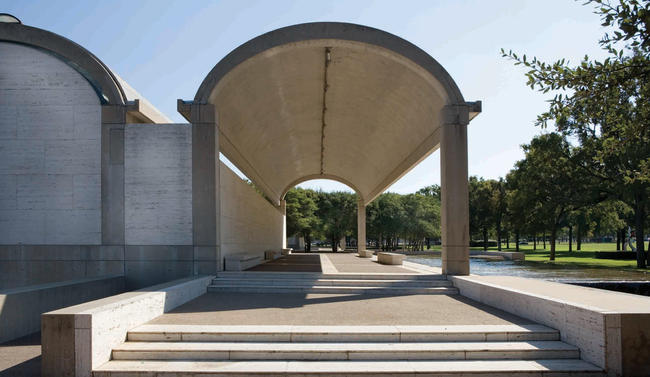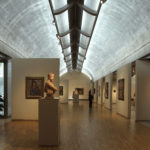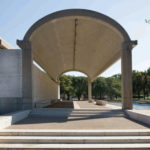Kimbell Art Museum | Fort Worth, Texas
ABOUT THE KIMBELL
Despite its relatively small size, the Kimbell Art Museum is justly famous for both the quality of its holdings and its iconic architecture. The museum’s original building, commissioned in 1966 from revered modernist architect Louis I. Kahn and considered one of his masterpieces, houses the permanent collection, comprising some 350 works from the ancient world, Europe, the Americas, Asia, Oceania, and Africa, and spanning more than five thousand years. An additional structure, designed by contemporary architect Renzo Piano and opened in 2013, contains galleries for special exhibitions, as well as education studios, an auditorium, and a sizable research library.
Kay Kimbell, a wealthy Fort Worth businessman, and his wife, Velma, acquired their first painting in 1931. They began buying art in earnest in 1935 and established the Kimbell Art Foundation in 1936. By the time of Kimbell’s death in 1964, the couple had amassed a collection exceeding 300 works, largely focused on British and French portraits of the eighteenth and nineteenth centuries. In his will, Kimbell left much of his estate to the foundation, charging it with expanding the collection and creating a museum. Shortly thereafter, his widow transferred her share of the community property to the foundation as well.
In 1965 the foundation hired Richard F. Brown, at that time director of the Los Angeles County Museum of Art, to direct the yet-to-be-built museum. Brown’s policy statement, issued in 1966, outlined the museum’s mission: to expand the collection’s geographic and historical scope while ensuring the individual excellence of each piece in it. For Brown, it was vital that the structure housing the collection be as beautiful as the objects it held; that same year he commissioned a design for the building from Kahn, who was known for his emphasis on natural light.
The completed edifice, which opened in 1972 on a site in downtown Fort Worth, is one of the loveliest places in America to see art. Combining modern and antique forms, it consists of five parallel rows of low barrel vaults, whose shape Kahn borrowed from ancient Roman warehouses. A defining feature of the structure is a narrow, plexiglas-covered channel running the entire length of each vault, beneath which hangs a pierced aluminum reflector that diffuses the incoming daylight throughout the space.
Facing the Kahn building across a broad lawn planted with trees is the elegant Piano Pavilion. Having worked for Kahn during construction of the original Kimbell building, Piano likewise worked magic with light in a structure that is both an homage to his mentor and a creation unmistakably his own.
In his 1966 statement, Brown prioritized singularity over historical completeness. Today, the museum’s acquisitions program is still guided by the belief that one exemplary object has more to teach the viewer than a room full of lesser pieces. Be that as it may, the Kimbell’s collection, while not much larger than it was in 1964, is at this point dizzyingly refined. Nevertheless, what it lacks in depth and volume, it more than makes up for in interest and appeal.
Though the Kimbell’s holdings include plenty of nonfigurative works, among them a delicate early eighteenth-century bowl by the Edo-period Japanese ceramicist Ogata Kenzan, the overall impression conveyed by the art in these galleries is of vigorous human life, evident in such treasures as a Mayan stone panel from the eighth century showing bound captives being presented to a king; a depiction of crafty cardsharps painted in 1595 by Caravaggio; a nineteenth-century African warrior ancestor figure, exuding competence from his foursquare stance to his neatly trimmed beard; and even James Ensor’s 1889 canvas Skeletons Warming Themselves.
In this partiality for human drama, the Kimbell continues to honor the taste of its founders, albeit in more diverse form. It honors them in another way as well: before there even was a museum, Kay and Velma Kimbell put their acquisitions on display for the people of Fort Worth, and true to those roots, the Kimbell offers free admission to the permanent collection.
Notable Kimbell Art Museum Paintings, Sculptures, and Objects
Joan Miró, Woman Addressing the Public: Project for a Monument, 1980–81. Inspired by the art of children, the French Surrealist first began sketching and painting fanciful creatures like the one here in the 1920s. Based on a 1971 maquette, this massive bronze sculpture was produced when the artist was eighty-seven.
Gustave Caillebotte, On the Pont de l’Europe, 1876–77. Though an important patron to the Impressionist painters, Caillebotte favored a more precisionist approach. Here, one of his best-known pictures shows Paris at a time of rapid modernization, the interiority of the three figures implying industrialization’s alienating effects.
Paul Cézanne, Maison Maria with a View of Chateau Noir, c. 1895. Modern art might have taken a different turn without Cézanne, whose work—particularly landscapes like this one, in which buildings, trees, sky, and land are treated as interlocking forms—was enormously influential on Braque and Picasso, the inventors of Cubism.
Rembrandt van Rijn, Bust of a Young Jew, 1663. Widely considered the greatest painter of Holland’s Golden Age, Rembrandt’s late works are notable for their bravura brushwork and psychological intensity. Although this moody painting of a young man was probably meant as a character study, there is no doubt that it is the likeness of a real person, probably a member of Amsterdam’s Jewish community.
Michelangelo Buonarroti, The Torment of Saint Anthony, 1487. Based on an engraving by the German artist Martin Schongauer (c. 1450–53–1491), this painting shows the saint being set upon in midair by fantastical demons. The first known painting by the Venetian master, it is thought to have been made when Michelangelo was only 12 or 13 years old.
Kaikei, Standing Shaka Buddha, c. 1210. One of only two known depictions by master Japanese sculptor Kaikei of Shakyamuni, the historical Buddha, this figure’s subtle kineticism—the deity seems about to step forward, while the edge of his robe is lifted by a light breeze—is typical of sculptures of the Kamakura period (1185–1333), when for the first time in Japanese history, artists signed their work.
Chinese, Horse and Rider, 2nd–1st century bc. This painted earthenware sculpture from the Han Dynasty was likely one of a regiment of model cavalrymen and soldiers from the tomb of a high-ranking military official. Though simple in form, it nevertheless transmits the liveliness of the horse—probably one of a prized breed from Central Asia—and the discipline of its rider.
Douris (painter), Red-Figure Cup Showing the Death of Pentheus (exterior) and a Maenad (interior), c. 480 bc. The Greek myth of Pentheus is rendered in gory detail in this cup from Douris, a vase painter of the early Classical period. Angered when Pentheus denied his divinity and banned worship of him, Dionysus bewitched his female followers, the Maenads, into believing Pentheus to be a wild animal; they tore him limb from limb in a frenzy, as Douris’s alarmingly realistic rendering depicts.
Ancient American, Seated Woman, c. 1500–1200 bc. Xochipala figures, so called because they were all found in a Mexican village of that name, are characterized by their naturalism, captured here in the subject’s tightly wrapped shawl, splayed toes, and quizzical expression.




